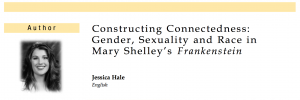In Jessica Hale’s article “Constructing Connectedness: Gender, Sexuality and Race in Mary Shelley’s Frankenstein”, she reveals four “relational trajectories” known as familial, homosocial, sexual, and racial in Mary Shelley’s Frankenstein by including and referencing to contemporary criticisms. The author then suggests that “these four levels of human interconnectedness” oppose the stability which the society “sought to establish” among families and races in the nineteenth century and thus exposing the fragility behind. For instance, the author conveys the idea of gendered dichotomy through the domesticity of Victor’s family. She declares that the excessive care from Alphonse, Viktor’s father upon his mother is a representative example of gender discrimination. Although the scene creates a harmonic impression of Viktor’s family, the undue submission of Caroline, Viktor’s mother demonstrates the stereotyped image of a female character in the nineteenth century. With a submissive attitude, Caroline surrenders to social expectations and thus isolating herself from the “outside world”. The author illustrates her point of gendered dichotomy with this passage and emphasizes the sexism behind the seemingly stable domesticity. In addition, the author proves her idea of racial discriminations lurking in the novel with Anne Mellor’s criticism in order to highlight how politicians from the nineteenth century identified the monster with racial terms. People from the past not only viewed the monster with speciesism but also racism. In the novel, people clearly recognize that the monster has “the shape of a man”, but they refuse to consider the monster as human being due to his “physical differences” which is a typical example of racism. In order to enhance her argument from different perspectives, the author indicates that Mellor has associated the monster with a “racial threat” as well, noting the way in which the politicians identified the slaves with Frankenstein’s monster.
There are many words that sound unfamiliar to me in this article such as “psychoanalytic” and “interconnectedness”. I have different approaches to identify these words based on how unfamiliar the word is to me. For example, a word like “psychoanalytic” sounds really unfamiliar to me, so I go to Merriam-Webster, which is an online dictionary and look this word up. This word basically means a psychological or mental analyzation. However, for a word like “interconnectedness”, which sounds less unfamiliar to me, I look for roots in that word. In this case, “inter” means connected and exchanging, “ness” is just a suffix for nouns. After identifying the roots, I am able to guess the meaning of the words, which in this case means a synergistic connection.

